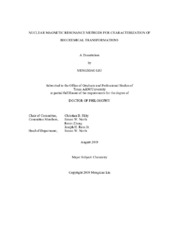| dc.description.abstract | As an analytical technique for structure determination and quantitative analysis, nuclear magnetic resonance (NMR) spectroscopy is widely used to characterize reactions or interactions. However, NMR is not readily applicable to probe fast processes because of its low sensitivity which requires long averaging time. This sensitivity issue can be solved using dissolution dynamic nuclear polarization (DNP), a hyperpolarization technique that enhances NMR signals by factors of 10³ – 10⁴. In this dissertation, DNP assisted NMR methods were developed to measure biochemical interactions and reactions on a rapid time scale, including protein-ligand interactions, enzymatic reactions, and in-cell metabolism. Through these measurements, information about kinetics and structures was obtained, which cannot be easily acquired through other methods. It was demonstrated that protein-ligand binding kinetics can be characterized rapidly by measuring relaxation dispersion from a single hyperpolarization. Moreover, the high sensitivity from DNP can reduce the acquisition interval to follow real-time biochemical reactions that complete within a few minutes. Modeling the time evolution of the reactant and product signals can result in detailed kinetic and relaxation parameters that contain structural information. In a reaction catalyzed by a metalloenzyme, the fitted relaxation rates due to paramagnetic relaxation enhancement (PRE) were used to calculate intermolecular distances in the enzyme-product complex structure, showing that real-time NMR together with PRE can be used to obtain kinetic and structural information simultaneously. Similar experiments are also applicable in live cells. An electroporator was hyphenated to facilitate the fast introduction of hyperpolarized precursors. Since arbitrary substrates can be introduced into cells within the detection time window, DNP-NMR can be used to access a broader range of in-cell reactions or interactions. The reaction time resolution in real-time NMR is limited primarily by the signal acquisition time. In the final part of this thesis, it is shown on the example of an enzymatic reaction that, this limit can be overcome by imaging the entire reaction progress in a continuous-flow mode. The higher time resolution achieved by this method can be used to acquire the kinetic profile of short-lived reaction intermediates. | en |


